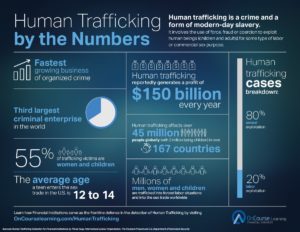
Make a Difference: EMS and Human Trafficking
When we think of trafficking, we generally think of drugs or weapons, not human beings. Yet the problem exists in numerous communities where EMS responders deliver care.
Human trafficking is defined by the United Nations as “the recruitment, transportation, transfer, harboring, or receipt of persons by improper means for an improper purpose.” (End Slavery Now, 2018, para. 1) A more succinct definition comes from Kathryn Brinsfield, MD, MPH, Assistant Secretary for Health Affairs and Chief Medical Officer for the Department of Homeland Security: “Human trafficking is modern-day slavery.” (DHS, 2017, para. 3)
Why is this so important in today’s EMS field? We are the first on scene, we are the ones invited inside where others are not and we are the ones who see an injured person’s environment. Our interactions with others can help us spot some of the tell-tale indicators.
Unfortunately, there are many reasons people are trafficked:
- Domestic Slavery: People are brought into private homes to work as slave labor, with no options to leave.
- Sex Trafficking: Children, men and women are forced into the commercial sex industry
- Forced and Bonded Labor: People are forced to work under the threat of violence for no pay — often to repay a debt — without the ability to leave
- Forced Marriage: Women and children are forced to marry another against their will and without their consent.
As an industry, there is much that EMS can do. We must keep our ears and eyes open, and report things that raise red flags in our minds. Some of the most common indicators we will see as emergency responders are:
- Signs of abuse, wounds or bruising in various stages of healing or malnutrition
- Scars or mutilations, including tattoos showing ownership
- Language or cultural barriers preventing injured persons from communicating with you
- Submissive or nervous appearances
- Security measures like overly hardened doors or windows preventing movement of people
DHS has a great educational sheet with additional indicators to look for: click here for a printable copy. While a particular situation may turn out not to be what you suspect, report your suspicions regardless so trained law enforcement experts can evaluate the situation. Your hunch may save a life or multiple lives. Call Immigration and Customs Enforcement at 1-866-DHS-2-ICE (1-866-347-2423) or online here. You can also receive additional training here.
References
Slavery Today (2018). Retrieved from http://www.endslaverynow.org/learn/slavery-today
EMS’s Role in the Effort to End Human Trafficking (2017). Retrieved from https://www.ems.gov/newsletter/marapr2016/end-human-trafficking.html
CATEGORIES
- AAA HQ
- Ambulance Chaser Blog
- Awards
- Community
- Drugs & Pharma
- Emergency Preparedness
- Events
- Executive
- Field Resources
- Finance
- Global EMS
- Government Affairs
- Human Resources
- Marketing & PR
- Member Advisories
- Member-Only
- News
- Operations
- Patient Care
- Press
- Professional Standards
- Publications
- Quality
- Reimbursement
- Savvik
- Spotlight
- Stars of Life
- Talking Medicare
- Technology
- Uncategorized
- Vehicle Standards
- Workforce Shortage
